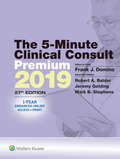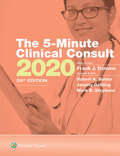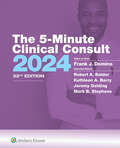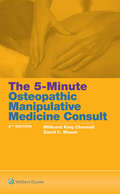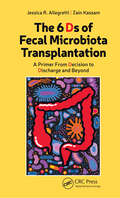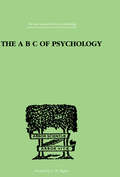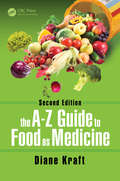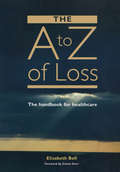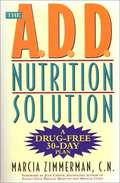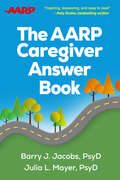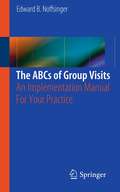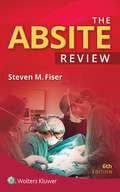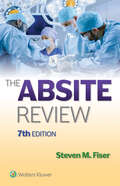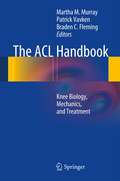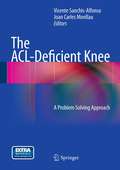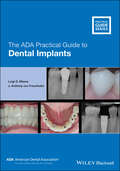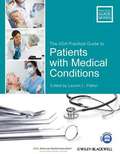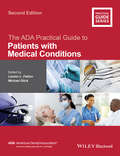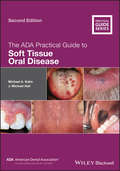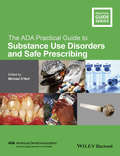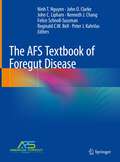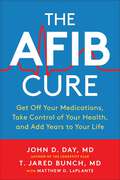- Table View
- List View
The 5-Minute Clinical Consult 2019 (The 5-Minute Consult Series)
by Frank J. Domino Robert A. Baldor Jeremy Golding Mark B. StephensMake the most effective diagnostic and therapeutic decisions quickly and efficiently! A best seller for over 25 years, The 5-Minute Clinical Consult 2019 is a practical, highly organized resource for clinicians in primary care, family medicine, emergency medicine, nursing, and pediatrics. It provides rapid access to guidance on diagnosis, treatment, medications, follow-up, and associated factors for more than 540 diseases and conditions. The 5-Minute Clinical Consult 2019 is designed to deliver maximum clinical confidence as efficiently as possible…allowing you to focus your valuable time on giving your patients the best possible care. Get quick access to all-new topics, including Advance Care Planning, Geriatric Care, and Medical Marijuana. Find the answers you need quickly thanks to an intuitive, at-a-glance format, with concise, bulleted text; hundreds of diagnostic and therapeutic algorithms; ICD-10 codes, DSM-5 criteria; and much more. Make confident decisions aided by current evidence-based designations in each topic.
The 5-Minute Clinical Consult 2020 (The 5-Minute Consult Series)
by Frank J. Domino Robert A. Baldor Jeremy Golding Mark B. StephensPractical and highly organized, The 5-Minute Clinical Consult 2020 is a reliable, go-to resource for clinicians in primary care, family medicine, emergency medicine, nursing, and pediatrics. This bestselling title provides rapid access to guidance on diagnosis, treatment, medications, follow-up, and associated factors for more than 540 diseases and conditions. The 5-Minute Clinical Consult 2020 delivers maximum clinical confidence as efficiently as possible … allowing you to focus your valuable time on giving your patients the best possible care. Get quick access to all-new content , including Internet Gaming Disorder, and a new algorithm for Tinnitus. Find the answers you need quickly thanks to an intuitive, at-a-glance format, with concise, bulleted text; hundreds of diagnostic and therapeutic algorithms; ICD-10 codes, DSM-5 criteria; and much more. Make confident decisions aided by current evidence-based designations in each topic. Written by esteemed internal medicine and family medicine practitioners and published by the leading publisher in medical content, The 5-Minute Clinical Consult 2020, 28th Edition includes a 10-Day Free Trial to 5MinuteConsult.com. 5MinuteConsult.com is an evidence-based, online workflow tool easily integrated at the point of care. 5MinuteConsult.com provides online-exclusive content, including: All-new topics, including Sports Medicine topics as they apply to Primary Care, Cannabinoid Hyperemesis Syndrome, Cholesteatoma, Rumination Syndrome, and Tinea Incognito, More than 1,500 additional topics, including the full contents of The 5-Minute Pediatric Consult and Rosen & Barkin’s 5-Minute Emergency Medicine Consult Differential diagnosis support from an expanded collection of algorithms Current evidence-based designations highlighted in each topic Thousands of images to help support visual diagnosis of all conditions A video library of procedures, treatment, and physical therapy techniques An A-to-Z Drug Database from Facts & Comparisons® Guidance on laboratory test interpretation from Wallach’s Interpretation of Diagnostic Tests More than 3,000 patient handouts in English and Spanish Approximately 100 Diseases and Conditions in Spanish ICD-10 codes and DSM-5 criteria FREE point-of-care CME and CE: 0.5 credits each time you search the site to find the best treatment for your patients. This activity has been reviewed and is acceptable for up to 20 prescribed credits by the AAFP and the ANCC.
The 5-Minute Clinical Consult 2024
by Frank DominoPractical and highly organized, the 5-Minute Clinical Consult 2024 provides rapid access to the diagnosis, treatment, medications, follow-up, and associated conditions for more than 500 disease and condition topics to help you make accurate decisions at the point of care. Organized alphabetically by diagnosis, it presents brief, bulleted points in a templated format, and contains more than 100 diagnostic and therapeutic algorithms. This up-to-date, bestselling reference delivers maximum clinical confidence as efficiently as possible, allowing you to focus your valuable time on providing high-quality care to your patients.
The 5-Minute Osteopathic Manipulative Medicine Consult
by Millicent King Channell David C. MasonNow in striking full color, this pocket-sized Second Edition of the first osteopathic clinical manual organized by diagnoses continues its proven quick-reference format. Presented in the tradition of The 5-Minute Consult Series , each diagnosis is presented in an at-a-glance, two-page spread. The first page defines the disease and lists associated autonomic and motor innervations and common somatic dysfunctions, while the second page lists appropriate techniques. ICD-10 billing codes, updated photos, and easy-to-understand schematic drawings combine with concise content to help readers make quick, accurate diagnoses that ensure the best possible care for every patient. Expanded coverage of OMM techniques and new color photos make the second edition an even more useful quick clinical reference.
The 6 Ds of Fecal Microbiota Transplantation: A Primer from Decision to Discharge and Beyond
by Jessica Allegretti Zain KassamA practical handbook on fecal microbiota transplantation (FMT) for physicians, nurses, physician assistants, students, residents, and fellows, The 6 Ds of Fecal Microbiota Transplantation: A Primer from Decision to Discharge and Beyond provides a clinical framework to understand and administer this treatment as safely and effectively as possible. FMT has emerged as a promising treatment for C. difficile infection (CDI), and there is a major need for educational resources on the topic. Drs. Jessica Allegretti, Zain Kassam, and their expert contributors are leaders in the field and have collectively cared for thousands of patients suffering from recurrent CDI who have benefitted from FMT. This guide provides practical tools, clinical pearls, and answers to frequently asked questions. Beginning with introductory information on the microbiome and exploring the history of FMT, The 6 Ds of Fecal Microbiota Transplantation outlines a step-by-step checklist for administering FMT: Decision: Who is the right CDI patient to receive FMT? What clinical questions should you ask patients in your FMT clinical assessment? Donor: How do you select and screen a donor for FMT? Discussion: What are the risks, benefits, and alternatives that need to be discussed with patients? Delivery: What is the best delivery method for FMT—colonoscopy, nasogastric tube, enema, or capsules? Discharge and follow-up: What is the ideal post-FMT care? How should you council patients following FMT? Discovery: What are the most promising emerging clinical applications for FMT? What is the evidence for FMT in obesity, autism, irritable bowel syndrome, inflammatory bowel disease, antibiotic resistant bacteria, and liver disease? Arming healthcare professionals with the ability to answer questions from patients regarding FMT and the microbiome, The 6 Ds of Fecal Microbiota Transplantationprovides a pragmatic guide for this exciting treatment.
The A B C Of Psychology (International Library Of Psychology Ser.)
by Ogden, C KFirst published in 1999. Routledge is an imprint of Taylor & Francis, an informa company.
The A-Z Guide to Food as Medicine, Second Edition
by Diane KraftReprising The 2017 American Library Association Outstanding Academic Title award-winning A-Z Guide to Food As Medicine, this new edition explores the physiological effects of more than 250 foods, food groups, nutrients, and phytochemicals in entries that include: Definition and background information such as traditional medicinal use, culinary facts, and dietary intake and deficiency information Scientific findings on the physiological effects of foods, food groups, and food constituents Bioactive dose when known, such as nutrient Dietary Reference Intakes focusing on 19-to-50-year-old individuals Safety highlights, such as nutrient Tolerable Upper Intake Levels A health professional’s comprehensive nutrition handbook that includes all nutrients, nutrient functions, "good" and "excellent" sources of nutrients, nutrient assessment, and deficiency symptoms, as well as summaries of foods, food groups, and phytochemicals. New to the Second Edition: Disease- and condition-focused Index that leads readers to foods used to manage specific conditions and diseases Focus on practical recommendations for health maintenance and disease prevention, including tables, insets, and updated scientific findings on more than a dozen new foods Accompanying teaching aids and lesson plans available online at http://www.crcpress.com Features: Dictionary-style summaries of the physiological effects of foods, food groups, nutrients, and phytochemicals alphabetically listed for quick access Approximately 60 B & W images of foods; informational tables and insets that define or illustrate concepts such as drug terminologies, classes of phytochemicals, and medicinal aspects of foods and of a plant-based diet Over 1,000 scientific references from peer-reviewed sources, including The Academy of Nutrition and Dietetics Evidence Analysis Library, and position statements of major health organizations
The A-Z of Loss: The Handbook for Health Care
by Elizabeth BellIn a unique approach this book links policy theory and research with the expertise of service providers and users to explore the major debates concerning the provision of mental health services. Many of these dilemmas revolve around questions of who makes the choices and who has control. The book examines the power and demands of the disparate groups involved in the provision and use of services before considering the different practice options and their implicit values and goals. This book will inform critical debate among all those involved in the mental health enterprise and challenge health professionals to consider their own practice. It is timely and relevant reading for practitioners and managers at every level in all disciplines and from all agencies as well as service users and carers.
The A. D. D. Nutrition Solution: A Drug-Free Thirty-Day Plan
by Marcia ZimmermanThe first scientifically proven, effective, all-natural nutritional alternative to the much-prescribed drug Ritalin. Attention deficit disorder is a nutritional deficiency, not a psychological condition. This is the revolutionary discovery Marcia Zimmerman made during her ten years of research as a nutritional biochemist. That conclusion led her to develop a diet that addresses the specific needs of the 17 million adults and children suffering from ADD. Her easy-to-follow thirty-day plan has been proven just as effective as Ritalin in relieving the symptoms of ADD. Learn: - How women should boost their nutrition before conception to prevent ADD in their children. - Why boys are much likelier to be tagged as ADD than girls - How to get a reliable ADD diagnosis Reasons why parents prefer a diet plan to prescription drugs for ADD children - The effects of brain allergies on attention span - Foods to avoid that may exacerbate ADD - Fats and oils we all need to stay focused - Calming effects of carbohydrates - Concentration-enhancing protein - Why to stay away from simple sugars - The dangers of artificial food ingredients, and much more This important book will help us curb the epidemic growth of ADD in this country and change the way we treat those who have it now by addressing its source instead of merely treating its symptoms.
The AARP Caregiver Answer Book
by Barry J. Jacobs Julia L. MayerIf you&’re among the millions of people annually who take on the role of providing unpaid care to family, friends, or neighbors, you are sure to face tough questions. How do I coordinate the care my loved one needs? How can I get other relatives to pitch in? Who pays for all this? Husband-and-wife psychologists Barry J. Jacobs and Julia L. Mayer--who have counseled family caregivers for over 30 years and cared for their own aging parents for a decade--have answers. Written in a Q&A format, this easy-to-navigate guide is packed with information, problem-solving and coping ideas, resources, stories, and communication tips. Drs. Jacobs and Mayer compassionately address everything you need to know to help your parent, spouse, or other care receiver. From managing family conflicts to hiring aides to optimizing end-of-life care, this is a book to return to at every step of the journey.
The ABCs of Group Visits
by Edward B. NoffsingerThe US healthcare system faces numerous difficulties: uncontrolled increases in costs; major access problems; doctor shortages; closing practices; inefficiencies; decreasing revenues; shrinking bottom lines; large numbers of uninsured and underinsured patients; and the upcoming increased demands in service posed by the Affordable Care Act. As a result, many physicians and health care organications are turning to group visits to address these problems. While Dr. Noffsinger's textbook Running Group Visits In Your Practice is the cornerstone reference on designing, implementing and running shared medical appointments (SMAs) in one's practice, it lacks the simplicity and practicality that clinicians are looking for to start their own SMA programs. The ABCs of Group Visits is a practical, streamlined and step-by-step guide focused on the implementation aspects of group visits.Healthcare professionals at every level are looking for alternate ways to deliver high quality care at lower cost, and it is clear to many that group visits provide a care delivery model that will address many of today's critical challenges. The ABCs of Group Visits quickly provides a solution for your busy practice.
The ABSITE Review
by Steven M. FiserThe first outline-style ABSITE review book is still the best! The ABSITE Review, 6th Edition, remains your #1 choice for effective, efficient review for this critically important exam. Written in a high-yield, memory-prompting outline format, Dr. Fiser’s concise handbook covers every topic on the American Board of Surgery In-Training Examination, thoroughly updated for today’s residents. It provides a rapid review of essential surgery information with sufficient explanation to build knowledge and confidence as you prepare for the ABSITE.
The ABSITE Review: High Yield Study Guide
by Steven M. FiserWritten in a high-yield, memory-prompting outline format, Dr. Steven Fiser’s The ABSITE Review, 7th Edition, covers every topic on the American Board of Surgery In-Training Examination, now thoroughly updated for today’s residents. This concise handbook offers a rapid review of essential surgery information with sufficient explanation to build knowledge and confidence as you prepare for this critically important exam.
The ACL Handbook
by Martha M. Murray Patrick Vavken Braden FlemingACL injuries affect the lives of hundreds of thousands of people each year. Treatment is far from perfect, and physicians and patients face challenges such as high failure rates in adolescent athletes and the inability to slow the accelerated progression of arthritis after an ACL rupture, for example. The ACL Handbook takes a complete view of ACL injuries and treatments, discussing: - Normal ACL and knee mechanics - The body's response to ACL injury - Development of new treatment methods Ideal for orthopedists, sports medicine physicians, and physical therapists, The ACL Handbook is a unique resource for information on the basic and applied science of ACL injury, repair, and the future of treatment.
The ACL-Deficient Knee
by Vicente Sanchis-Alfonso Joan Carles MonllauThis book approaches the ACL deficient knee from a different perspective than those of the previous classical ways. The common approach is the analysis of closed compartments; anatomy, biomechanics, physical findings, imaging, surgical treatment and rehabilitation. The approach of this book is completely opposite, focusing on questions, controversies, problem analyses and problem solving, besides analyzing the possibility of prevention. Therefore, in each chapter, the biomechanics, anatomy, and other areas that are relevant to the topic are reviewed. There are chapters where highly specialized surgical techniques are presented (acute ACL repair, double bundle reconstruction, chondral lesions treatment or meniscal transplant). These chapters are written by internationally renowned specialists that are pioneers in the topic analyzed. Another interesting aspect of this book are the step by step surgical techniques videos, that will allow a knee specialist to perform the technique presented by the author. Moreover, the videos will include anatomy and physical therapy techniques.
The ADA Practical Guide to Dental Implants (ADA Practical Guide)
by J. Anthony von Fraunhofer Luigi O. MassaThis clinically oriented book gives dental practitioners and students a hands-on guide to incorporating dental implants into their practices. Taking a clear and concise approach to the subject, the book offers basic information on all aspects of dental implants. Topics covered encompass the pros and cons of implants, patient factors, clinical considerations to success and failure, and implant restoration. Photographs, radiographs, and illustrations support the text, demonstrating the concepts discussed. The ADA Practical Guide to Dental Implants starts with a brief history of the subject then examines the clinical and economic considerations for implants. Patient factors, including systemic, oral, and periodontal health, diet, age, gender, and more are discussed. The book also looks at the experience of the clinician, followed by clinical considerations such as case planning, implant design, surgical techniques, antibiotics, and more. The last chapters cover post-surgical follow-up and the many factors that lead to a successful outcome. Discusses all aspects of dental implantology in the practice setting Supports dental practitioners in incorporating dental implants into their practices Considers pros and cons, patient factors, clinical considerations, success and failure, and implant restoration Offers foundational information on dental implants in an easy-to-read format Includes photographs and drawings to depict the concepts discussed The ADA Practical Guide to Dental Implants is a useful introduction and guide to dental implants for any practitioner interested in incorporating implants into clinical practice.
The ADA Practical Guide to Patients with Medical Conditions
by Lauren L. PattonWith new medications, medical therapies, and increasing numbers of older and medically complex patients seeking dental care, all dentists, hygienists, and students need to understand the background of common diseases, medical management, and dental management to coordinate and deliver safe care. Written by more than 25 academicians and clinicians who are experts in the content areas, the evidence-based Practical Guide from the American Dental Association takes a patient-focused approach to help you deliver safe, coordinated oral health care for patients with medical conditions. Systems-based, user-friendly format to save you time! Each chapter of this Practical Guide discusses individual conditions clearly organized under three headings: background, medical management, and dental management Other sections include: disease descriptions, pathogenesis, coordination of care between the dentist and physician, and key questions to ask the patient and physician Key features that make this a must-have book: Coverage of clinical topics including: Cardiovascular Disease, Pulmonary Disease, Endocrine Disorders, Bleeding Disorders, Neurologic Disorders, Neurodevelopmental and Psychiatric Disorders, Geriatric Health and Functional Issues, Neurodevelopmental and Psychiatric Disorders, HIV/AIDS and Related Conditions and much more Identification of risks related to hemostasis, susceptibility to infection, drug actions/interactions, and ability to tolerate dental care, specific to the patient's medical condition More than 200 clinical images - which you can downloaded from the book's website! Over 75 summary tables to help you digest vital information Quick reference points and guides to key dental care issues in each chapter Companion website with downloadable images and tables and a webliography with click-through links to online sources at www. wiley. com/go/patton Help your patients improve their oral and overall health. Order today! You can purchase a print copy of this book directly from the American Dental Association.
The ADA Practical Guide to Patients with Medical Conditions
by Lauren L. Patton Michael GlickWith new medications, medical therapies, and increasing numbers of older and medically complex patients seeking dental care, all dentists, hygienists, and students need to understand the background of common diseases, medical management, and dental management to coordinate and deliver safe care. Written by more than 25 academicians and clinicians who are experts in the content areas, the evidence-based Practical Guide from the American Dental Association takes a patient-focused approach to help you deliver safe, coordinated oral health care for patients with medical conditions.
The ADA Practical Guide to Soft Tissue Oral Disease
by J. Michael Hall Michael A. KahnThe ADA Practical Guide to Soft Tissue Oral Disease is the perfect tool to aid in identifying, diagnosing and treating soft tissue oral disease in everyday clinical practice. Focusing on the clinical aspects of management required by the general dental team, this book expertly guides readers through screening examinations, description and documentation, differential diagnosis, and guidelines for observation and referral.Ideal as a clinical handbook or review guide, The ADA Practical Guide to Soft Tissue Oral Disease is replete with color photos, case studies and discussion, and synopses of best current treatments based on up-to-date literature. Section 1 includes basic information of how to most effectively and efficiently perform a complete and thorough head and neck soft tissue screening examination. Section 2 presents an overview of the top 40 oral soft tissue lesions, as well as several less common but life?-threatening conditions such as oral cancer and infections. Section 3 is composed of a series of brief patient clinical scenarios with diagnostic exercises for self?-test and evaluation by providing discussion of the correct diagnosis and distractors.
The ADA Practical Guide to Soft Tissue Oral Disease (ADA Practical Guide)
by J. Michael Hall Michael A. KahnThe ADA Practical Guide to Soft Tissue Oral Disease, Second Edition is a fully updated new edition of this popular guide to oral and maxillofacial diseases likely to be encountered in general or specialist dental practices. Easy-to-use, updated resource with brief synopses for everyday clinical reference Includes self-testing clinicopathologic exercises to help readers further their skills and gain confidence in their knowledge Focuses on decision making, from communicating diagnoses to developing and discussing treatment plans Presents clinically oriented information on the most important aspects of common oral and maxillofacial diseases Features detailed color illustrations, treatment algorithms, differential diagnosis, and case examples with discussion
The ADA Practical Guide to Substance Use Disorders and Safe Prescribing
by Michael O'NeilDentists have been inundated by patients with an array of complicated medical conditions and pain/sedation management issues. This is in addition to a variety of legal regulations dentists must follow regarding the storage and recordkeeping of controlled substances. Avoid unknowingly putting your practice at risk by becoming victim to a scam or violating a recordkeeping requirement with The ADA Practical Guide to Substance Use Disorders and Safe Prescribing. This Practical Guide is ideal for dentists and staff as they navigate: * Detecting and deterring substance use disorders (SUD) and drug diversion in the dental office (drug-seeking patients) * Prescribing complexities * Treating patients with SUD and complex analgesic and sedation (pain/sedation management) needs and the best use of sedation anxiety medication * Interviewing and counselling options for SUD * Federal drug regulations Commonly used illicit, prescription, and over-the-counter drugs, as well as alcohol and tobacco, are also covered. Special features include: * Clinical tools proven to aid in the identification, interviewing, intervention, referral and treatment of SUD * Basic elements of SUD, acute pain/sedation management, and drug diversion * Summary of evidence-based literature that supports what, when and how to prescribe controlled substances to patients with SUD * Discussion of key federal controlled substance regulations that frequently impact dental practitioners * Checklists to help prevent drug diversion in dental practices * Chapter on impaired dental professionals * Case studies that examine safe prescribing and due diligence
The ADME Encyclopedia: A Comprehensive Guide on Biopharmacy and Pharmacokinetics
by Alan TaleviThe ADME Encyclopedia covers pharmacokinetic phenomena (Absorption, Distribution, Metabolism and Excretion processes) and their relationship with the design of pharmaceutical carriers and the success of drug therapies. It covers both basic and advanced knowledge, serving as introductory material for students of biomedical careers and also as reference, updated material for graduates and professionals working in any field related to pharmaceutical sciences (medicine, pharmaceutical technology, materials science, medicinal chemistry). Structured as alphabetically ordered entries with cross-references, the Encyclopedia not only provides basic knowledge on ADME processes, but also detailed entries on some advanced subjects such as drug transporters, last generation pharmaceutical carriers, pharmacogenomics, personalized medicine, bioequivalence studies, biowaivers, biopharmaceuticals, gene delivery, pharmacometrics, pharmacokinetic drug interactions or in silico and in vitro assessment of ADME properties
The AFS Textbook of Foregut Disease
by Ninh T. Nguyen Peter J. Kahrilas John O. Clarke John C. Lipham Kenneth J. Chang Felice Schnoll-Sussman Reginald C. W. BellThe AFS Textbook of Foregut Disease serves as a comprehensive guide of information covering the fast-evolving field of foregut disease. This textbook is designed as a partnership between gastroenterologists & gastrointestinal surgeons with an understanding that an essential component of moving forward in this field is through collaboration. This AFS textbook has been developed by the American Foregut Society, a premier society for foregut disease and all chapters are written by experts in the field. Readership is intended for gastroenterologists, GI and thoracic surgeons, gastroenterology and general surgery residents and fellows, medical students, and integrated health members that manage foregut disease. All chapters follow an organized format that contains many graphs, tables, intraoperative photographs, and illustrations of techniques. This textbook provides the most up-to-date scientific information and will be the definitive resource to guide both the diagnosis and management of foregut disease for years to come.
The AFib Cure, Updated Ediiton: Get Off Your Medications, Take Control of Your Health, and Add Years to Your Life
by John D. Day T. Jared Brunch MDMost doctors will tell you that there isn't much you can do to treat atrial fibrillation, aside from taking medications for the rest of your life. Cardiologists and a-fib specialists John D. Day and T. Jared Bunch disagree.Atrial fibrillation strikes one in four American adults. Not only do people suffering from this condition suffer from shortness of breath, fatigue, chest discomfort, decreased ability to exercise and do activities of daily living, arrhythmia, and palpitations, but their risk of a stroke, cognitive decline and dementia, heart failure, or premature death also shoots way up. Today, a whole new body of research—one most physicians are unaware of—shows that biomarker and lifestyle optimization may put half the cases of atrial fibrillation into remission without drugs or procedures. And for those in whom these remedies are insufficient or not tolerated, new procedures, in combination with biomarker and lifestyle optimization, may offer lifetime remission from atrial fibrillation and its devastating consequences. In clear, accessible, patient-centric language, Drs. Day and Bunch share their revolutionary approach to treating atrial fibrillation, developed through a combined 53 years working with a-fib patients. The effectiveness of their plan has been proven through countless medical studies. And now, in The AFib Cure: Get Off Your Medications, Take Control of Your Health, and Add Years to Your Life, they share that plan with you. If you're looking for a drug-free solution to your atrial fibrillation, or have a family history of atrial fibrillation and don't want to suffer the same fate, The AFib Cure is for you. Let The AFib Cure show you how to live longer, healthier, free from medications, and free from the fear of atrial fibrillation overshadowing your life.
The AFib Cure: Get Off Your Medications, Take Control of Your Health, and Add Years to Your Life
by John D. Day Matthew LaPlante T. Jared BunchMost doctors will tell you that there isn't much you can do to treat atrial fibrillation, aside from taking medications for the rest of your life. Cardiologists and a-fib specialists John D. Day and T. Jared Bunch disagree. Atrial fibrillation strikes one in four American adults. Not only do people suffering from this condition suffer from shortness of breath, fatigue, chest discomfort, decreased ability to exercise and do activities of daily living, arrhythmia, and palpitations, but their risk of a stroke, cognitive decline and dementia, heart failure, or premature death also shoots way up. Today, a whole new body of research—one most physicians are unaware of—shows that biomarker and lifestyle optimization may put half the cases of atrial fibrillation into remission without drugs or procedures. And for those in whom these remedies are insufficient or not tolerated, new procedures, in combination with biomarker and lifestyle optimization, may offer lifetime remission from atrial fibrillation and its devastating consequences. In clear, accessible, patient-centric language, Drs. Day and Bunch share their revolutionary approach to treating atrial fibrillation, developed through a combined 53 years working with a-fib patients. The effectiveness of their plan has been proven through countless medical studies. And now, in The AFib Cure: Get Off Your Medications, Take Control of Your Health, and Add Years to Your Life, they share that plan with you. If you're looking for a drug-free solution to your atrial fibrillation, or have a family history of atrial fibrillation and don't want to suffer the same fate, The AFib Cure is for you. Let The AFib Cure show you how to live longer, healthier, free from medications, and free from the fear of atrial fibrillation overshadowing your life.
